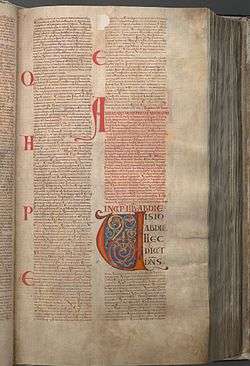Amos 6
| Amos 6 | |
|---|---|
 | |
| Book | Book of Amos |
| Bible part | Old Testament |
| Order in the Bible part | 30 |
| Category | Nevi'im |
Amos 6 is the sixth chapter of the Book of Amos in the Hebrew Bible or the Old Testament of the Christian Bible.[1][2] This book contains the prophecies spoken by the prophet Amos, especially denunciation of both the sister nations for wanton security — Zion, as well as Samaria; the voluptuousness of Israel, Amos 6:1-6, shall be punished with desolation, Amos 6:7-11; their perversion of justice and vain confidence shall end in affliction, Amos 6:12-14.[3] It is a part of the Book of the Twelve Minor Prophets.[4][5]
Text
- The original text is written in Hebrew language.
- This chapter is divided into 14 verses.
Textual versions
Some most ancient manuscripts containing this chapter in Hebrew language:
- Masoretic Text (10th century)
- Dead Sea Scrolls: (2nd century BC)[6][7]
Ancient translations in Koine Greek:
- Septuagint (3rd century BC)
- Theodotion version (~AD 180)
Structure
NKJV groups this chapter into:
- Amos 6:1-14 = Warnings to Zion and Samaria
Verse 1
- Woe to them that are at ease in Zion,
- and trust in the mountain of Samaria,
- which are named chief of the nations,
- to whom the house of Israel came![8]
- "Them that are at ease in Zion": living in fancied security and self-pleasing (Isaiah 32:9, 11; Zephaniah 1:12). Judah is included in the denunciation, because she is equally guilty; the whole covenant nation is sunk in the same dangerous apathy. Septuagint, τοῖς ἐξουθενοῦσι Σιών, "them that set at naught Zion." The same rendering is found in the Syriac, and can be supported by a small change in the Hebrew. It may have been intended thus to confine the announcement to Israel alone, in conformity with the prophet's chief scope. But he has introduced mention of Judah elsewhere, as Amos 2:4; Amos 6:5; Amos 9:11, and his sense of his own people's careless ease may well lead him to include them in his warning.[9]
- "Trust in the mountain of Samaria": Not in God. Samaria was strong (see Amos 3:9), resisted for three years, and was the last city of Israel which was taken. "The king of Assyria came up throughout all the land and went up to Samaria, and besieged it 2 Kings 17:5. Benhadad, in that former siege, when God delivered them 2 Kings 7:6, attempted no assault, but famine only.[10]
- "Which are named the chief of the nations": the persons at ease in Zion, and trusted in Samaria, were the principal men of both nations, Judah and Israel; or these cities of Zion and Samaria were the chief of the said nations: Zion, Which was near Jerusalem, and includes it, was the metropolis of Judea; as Samaria was the head city of Ephraim, or the ten tribes. The Targum is, that "put the name of their children, as the name of the children of the nations;" as the Jews did in later times, giving their children the names of Alexander, Antipater, etc.[11]
- "To whom the house of Israel came": to which places all Israel had recourse; so the two tribes went up to Zion, the ten tribes went to Samaria: or, to whom, i.e. to which nobles and rulers, the people of each kingdom did go on all occasions for judgment, counsel, or refuge.[3]
See also
Notes and references
- ↑ Collins 2014.
- ↑ Hayes 2015.
- 1 2 Robert Jamieson, Andrew Robert Fausset; David Brown. Jamieson, Fausset, and Brown's Commentary On the Whole Bible. 1871.

- ↑ Metzger, Bruce M., et al. The Oxford Companion to the Bible. New York: Oxford University Press, 1993.
- ↑ Keck, Leander E. 1996. The New Interpreter's Bible: Volume: VII. Nashville: Abingdon.
- 1 2 3 Dead sea scrolls - Amos
- ↑ Timothy A. J. Jull; Douglas J. Donahue; Magen Broshi; Emanuel Tov (1995). "Radiocarbon Dating of Scrolls and Linen Fragments from the Judean Desert". Radiocarbon. 38 (1): 14. Retrieved 26 November 2014.
- ↑ Amos 6:1
- ↑ Joseph S. Exell; Henry Donald Maurice Spence-Jones (Editors). The Pulpit Commentary. 23 volumes. First publication: 1890.

- ↑ Barnes, Albert. Notes on the Old Testament. London, Blackie & Son, 1884. Reprint, Grand Rapids: Baker Books, 1998.

- ↑ John Gill. John Gill's Exposition of the Entire Bible. Exposition of the Old and New Testament. Published in 1746-1763.

Bibliography
- Collins, John J. (2014). Introduction to the Hebrew Scriptures. Fortress Press.
- Hayes, Christine (2015). Introduction to the Bible. Yale University Press.
External links
Jewish
Christian
This article is issued from
Wikipedia.
The text is licensed under Creative Commons - Attribution - Sharealike.
Additional terms may apply for the media files.